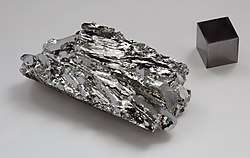molybdenum
English
| Chemical element | |
|---|---|
| Mo | Previous: niobium (Nb) |
| Next: technetium (Tc) | |

Molybdenum cube and fragment.
Etymology
From New Latin molybdaenum, from molybdaena (“any of various substances resembling lead”), from Ancient Greek μολύβδαινα (molúbdaina, “a plummet, piece of lead”), from μόλυβδος (mólubdos, “lead; graphite”), from an Anatolian word cognate with Lydian 𐤪𐤠𐤭𐤦𐤥𐤣𐤠 (mariwda, “dark”), from Proto-Indo-European *morkʷ-iyo-, from a root *morkʷ- (“dark”)
Attested since the last quarter of 18th century.
Pronunciation
- enPR: məlĭb'dĭnəm, IPA(key): /məˈlɪbdɪnəm/
Noun
molybdenum (countable and uncountable, plural molybdenums or molybdena)
- A metallic chemical element (symbol Mo) with an atomic number of 42.
- 1803, “Of Metals”, in George Gleig, editor, Supplement to the Third Edition of the Encyclopædia Britannica, or, A Dictionary of Arts, Sciences, and Miscellaneous Literature, volume I, 2nd edition, page 225:
- The metals at preſent amount to 21 ; only 11 of which were known before the year 1730. Their names are gold, ſilver, platinum, mercury, copper, iron, tin, lead, zinc, antimony, biſmuth, arſenic, cobalt, nickel, manganeſe, tungſten, molybdenum, uranium, tellurium, titanium, chromum.
-
- A single atom of this element.
- a quadruple bond between molybdenums
- 2007, Peter Day, Molecules into Materials: Case Studies in Materials Chemistry—Mixed Valency, Magnetism and Superconductivity, page 233:
- Thus in M4O11, for example, ¾ of the molybdenums are octahedrally connected and ¼ are tetrahedrally coordinated and, furthermore, the formula is compatible with the existence of one Mo(IV) for every three Mo(VI), so at first glance the compound might appear to be a class I mixed valence system.
Derived terms
Derived terms
- ferromolybdenum
- moly
- molybdate
- molybdenated
- molybdenian
- molybdenum blue
- molybdenum carbonyl
- molybdenum chloride
- molybdenum disulfide, molybdenum disulphide
- molybdenum hexacarbonyl
- molybdenum orange
- molybdenum oxide
- molybdenum sulfide, molybdenum sulphide
- molybdenum trioxide
- molybdian
- molybdo-
Related terms
Translations
chemical element
|
|
This article is issued from
Wiktionary.
The text is licensed under Creative
Commons - Attribution - Sharealike.
Additional terms may apply for the media files.